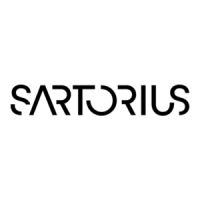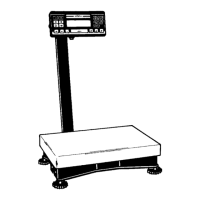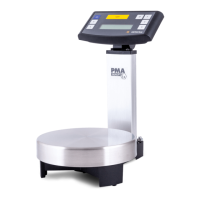Do you have a question about the Sartorius QC64EDE-S and is the answer not in the manual?
Instructions for removing the transport locking device before initial operation of the scale.
Information regarding the verification mark and its implications for scale servicing.
Details on the intended applications and suitability of the QC series counting scales.
Information on completing and returning the warranty registration card for full benefits.
Guidelines for setting up the scale under optimal ambient conditions for speed and accuracy.
Information on operating the scale in hazardous areas and applicable regulations.
Step-by-step instructions for mounting the display unit on a table or wall.
Procedure for leveling the scale accurately using the built-in level indicator.
Detailed instructions for attaching the raised display to the short side of the scale.
Detailed instructions for attaching the raised display to the long side of the scale.
Instructions for mounting the optional remote display unit.
Guidance on removing transport locking devices before initial scale operation.
Information on the verification mark indicating scale integrity and servicing.
Safety measures for connecting the scale to AC power, especially in safe areas.
Instructions for positioning the display unit to the desired angle.
Information on installing drive-on ramps by trained personnel.
Explanation of CE marking compliance with European directives and standards.
Details on EMC directive, regulating interference and emissions for equipment.
Information on the directive governing non-automatic weighing instruments for legal metrology.
Procedure for powering the scale on and off using the ON/OFF key.
Description of the automatic self-test performed when the scale is switched on.
Instructions for safely connecting peripheral devices to the scale's interface port.
Notes on electrical connections and potential interference when interfacing devices.
Information on regular servicing by technicians to ensure scale accuracy and lifespan.
Procedure for cleaning the scale using mild detergent and avoiding liquid ingress.
Guidance on returning packaging materials for environmentally friendly recycling.
How to define scale settings to adapt to ambient conditions and meet specific requirements.
Steps for selecting specific functions by changing the respective menu code.
How to adapt the scale to prevailing ambient conditions at the installation site.
Adapting the scale for standard weighing or manual filling based on requirements.
Setting the stability range to ensure the stability symbol remains displayed with weight variations.
Configuration options for the baud rate of the interface communication.
Selection of parity settings (Mark, Space, Odd, Even) for data transmission.
Setting parameters for data output, coupled with the stability parameter.
Configuration and control of the automatic data output (auto print) function.
Options for automatic or manual data record output depending on menu settings.
Defining the menu access switch function to allow or block menu code changes.
Options for blocking all keys except ON/OFF, or blocking number keys.
Setting the power-on mode to meet individual requirements based on power source.
Using the counting program based on reference piece count or reference weight.
Storing weighed values and subtracting container weight.
Summation of weighed values and piece counts for breaking bulk and portioning.
Overview of basic functions within the counting program.
Minimum load requirements for storing reference weights to ensure counting accuracy.
Selecting limit parameters for storing weighed values when determining piece weight.
Example of automatic reference updating for constant piece weight scenarios.
Overview of key functions within the Tare Memory program.
Overview of functions for totaling weighed values and piece counts.
Overview of functions for checking samples within specific tolerance ranges.
Practical example demonstrating how to check the weight of bulk parts.
Example of checking piece count for bulk parts with identical weights.
Overview of functions for entering and managing individual data ID codes.
Overview of functions for storing and retrieving tare values, reference values, etc.
List of error codes indicating operating and routine errors recognized by the scale.
Overview of the scale's interface port for connecting to computers or peripheral devices.
Notes on electrical connections and potential interference when interfacing devices.
Explanation of character definitions for data output strings.
List and explanation of unit symbols used in data output.
Codes indicating special status conditions like Tare, Calibrate, Overload, Underload.
Codes indicating specific error types (one-place and two-place error codes).
Format requirements for transmitting control commands to the scale.
Commands using upper-case letters for processor reinitialization and scale control.
Commands using lower-case letters to activate application programs via interface.
Instruction to enter the fixed 2-line header and ID label for the scale.
Provides a simplified BASIC program version for setting print headers.
Reference table for ASCII characters and their decimal equivalents.
Explanation of data communication and ASCII character transmission via interface.
Details on software and hardware handshake parameters for data transmission.
Activating data output via software command or key press.
Configuring automatic data output at defined intervals or immediately upon scale power-on.
Parameters for controlling data output based on stability or print commands.
Settings for stopping/starting or making autoprint function non-stoppable.
Options for including or excluding data ID codes in the output.
Configuration for outputting company name and header lines on printouts.
Example showing control line usage within the check range for external displays.
Diagram and pin assignment for the 12-pin round interface connector.
Pin labeling details for the 25-position D-SUB female connector.
Warning about checking pin assignments of non-Sartorius RS-232 cables.
Connection assignments for the cable between the QC scale and RS-232 PC interface.
Scale drawings and dimensions for QC7DCE models.
Scale drawings and dimensions for QC34/64 EDE models.
Specifications and order numbers for the Sartorius Data Printer.
Information on the remote display unit connectable via the interface port.
Details of the IP 65-protected AC adapter with specified cable lengths.
List of external standard calibration weights with accuracy class and order numbers.
Information on universal remote switches and their menu code definable functions.
Overview of essential keys and their corresponding functions on the scale.
Basic steps for performing simple weighing operations on the scale.
Procedure for external adjustment and calibration using specific menu codes.
Summary of key menu codes for weighing parameters like ambient conditions and stability.
Menu codes for adapting the scale to different ambient conditions.
List of selectable weight units and their corresponding menu codes.
Configuration options for data output, including stability and print commands.
Settings for controlling the autoprint function, including stopping and intervals.
Settings for the scale's power-on mode based on power source and auto shut-off.
Enables resetting all menu codes to original factory settings.
Instructions for removing the transport locking device before initial operation of the scale.
Information regarding the verification mark and its implications for scale servicing.
Details on the intended applications and suitability of the QC series counting scales.
Information on completing and returning the warranty registration card for full benefits.
Guidelines for setting up the scale under optimal ambient conditions for speed and accuracy.
Information on operating the scale in hazardous areas and applicable regulations.
Step-by-step instructions for mounting the display unit on a table or wall.
Procedure for leveling the scale accurately using the built-in level indicator.
Detailed instructions for attaching the raised display to the short side of the scale.
Detailed instructions for attaching the raised display to the long side of the scale.
Instructions for mounting the optional remote display unit.
Guidance on removing transport locking devices before initial scale operation.
Information on the verification mark indicating scale integrity and servicing.
Safety measures for connecting the scale to AC power, especially in safe areas.
Instructions for positioning the display unit to the desired angle.
Information on installing drive-on ramps by trained personnel.
Explanation of CE marking compliance with European directives and standards.
Details on EMC directive, regulating interference and emissions for equipment.
Information on the directive governing non-automatic weighing instruments for legal metrology.
Procedure for powering the scale on and off using the ON/OFF key.
Description of the automatic self-test performed when the scale is switched on.
Instructions for safely connecting peripheral devices to the scale's interface port.
Notes on electrical connections and potential interference when interfacing devices.
Information on regular servicing by technicians to ensure scale accuracy and lifespan.
Procedure for cleaning the scale using mild detergent and avoiding liquid ingress.
Guidance on returning packaging materials for environmentally friendly recycling.
How to define scale settings to adapt to ambient conditions and meet specific requirements.
Steps for selecting specific functions by changing the respective menu code.
How to adapt the scale to prevailing ambient conditions at the installation site.
Adapting the scale for standard weighing or manual filling based on requirements.
Setting the stability range to ensure the stability symbol remains displayed with weight variations.
Configuration options for the baud rate of the interface communication.
Selection of parity settings (Mark, Space, Odd, Even) for data transmission.
Setting parameters for data output, coupled with the stability parameter.
Configuration and control of the automatic data output (auto print) function.
Options for automatic or manual data record output depending on menu settings.
Defining the menu access switch function to allow or block menu code changes.
Options for blocking all keys except ON/OFF, or blocking number keys.
Setting the power-on mode to meet individual requirements based on power source.
Using the counting program based on reference piece count or reference weight.
Storing weighed values and subtracting container weight.
Summation of weighed values and piece counts for breaking bulk and portioning.
Overview of basic functions within the counting program.
Minimum load requirements for storing reference weights to ensure counting accuracy.
Selecting limit parameters for storing weighed values when determining piece weight.
Example of automatic reference updating for constant piece weight scenarios.
Overview of key functions within the Tare Memory program.
Overview of functions for totaling weighed values and piece counts.
Overview of functions for checking samples within specific tolerance ranges.
Practical example demonstrating how to check the weight of bulk parts.
Example of checking piece count for bulk parts with identical weights.
Overview of functions for entering and managing individual data ID codes.
Overview of functions for storing and retrieving tare values, reference values, etc.
List of error codes indicating operating and routine errors recognized by the scale.
Overview of the scale's interface port for connecting to computers or peripheral devices.
Notes on electrical connections and potential interference when interfacing devices.
Explanation of character definitions for data output strings.
List and explanation of unit symbols used in data output.
Codes indicating special status conditions like Tare, Calibrate, Overload, Underload.
Codes indicating specific error types (one-place and two-place error codes).
Format requirements for transmitting control commands to the scale.
Commands using upper-case letters for processor reinitialization and scale control.
Commands using lower-case letters to activate application programs via interface.
Instruction to enter the fixed 2-line header and ID label for the scale.
Provides a simplified BASIC program version for setting print headers.
Reference table for ASCII characters and their decimal equivalents.
Explanation of data communication and ASCII character transmission via interface.
Details on software and hardware handshake parameters for data transmission.
Activating data output via software command or key press.
Configuring automatic data output at defined intervals or immediately upon scale power-on.
Parameters for controlling data output based on stability or print commands.
Settings for stopping/starting or making autoprint function non-stoppable.
Options for including or excluding data ID codes in the output.
Configuration for outputting company name and header lines on printouts.
Example showing control line usage within the check range for external displays.
Diagram and pin assignment for the 12-pin round interface connector.
Pin labeling details for the 25-position D-SUB female connector.
Warning about checking pin assignments of non-Sartorius RS-232 cables.
Connection assignments for the cable between the QC scale and RS-232 PC interface.
Scale drawings and dimensions for QC7DCE models.
Scale drawings and dimensions for QC34/64 EDE models.
Specifications and order numbers for the Sartorius Data Printer.
Information on the remote display unit connectable via the interface port.
Details of the IP 65-protected AC adapter with specified cable lengths.
List of external standard calibration weights with accuracy class and order numbers.
Information on universal remote switches and their menu code definable functions.
Overview of essential keys and their corresponding functions on the scale.
Basic steps for performing simple weighing operations on the scale.
Procedure for external adjustment and calibration using specific menu codes.
Summary of key menu codes for weighing parameters like ambient conditions and stability.
Menu codes for adapting the scale to different ambient conditions.
List of selectable weight units and their corresponding menu codes.
Configuration options for data output, including stability and print commands.
Settings for controlling the autoprint function, including stopping and intervals.
Settings for the scale's power-on mode based on power source and auto shut-off.
Enables resetting all menu codes to original factory settings.











